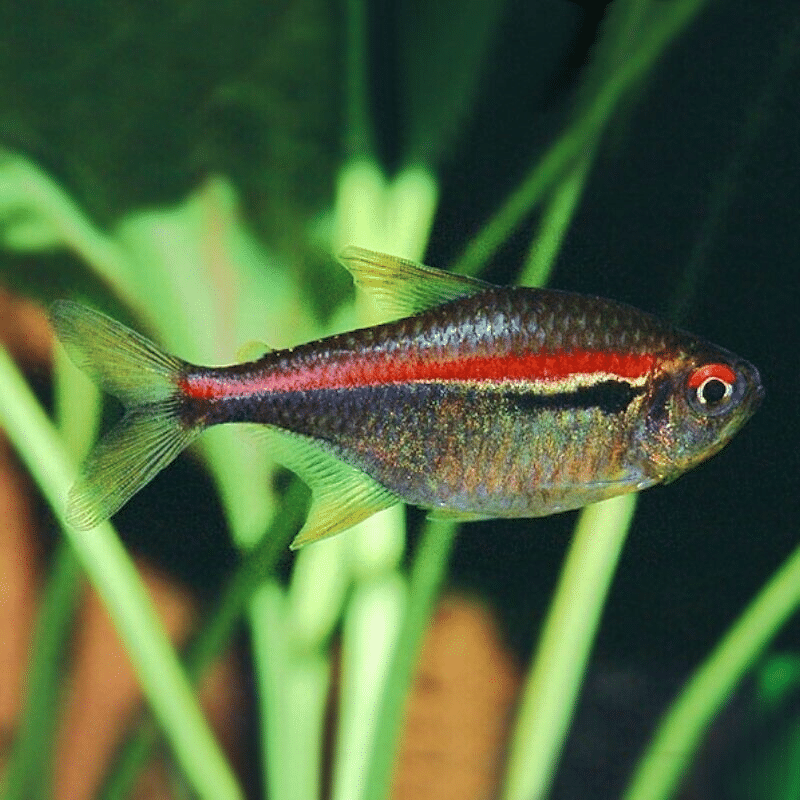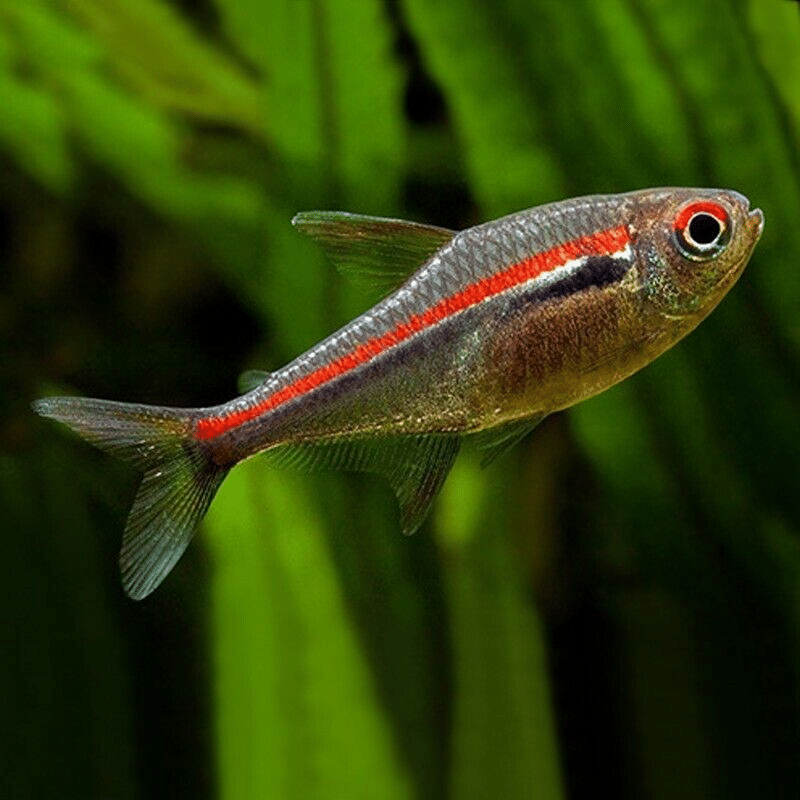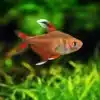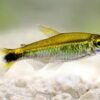Vibrant and Captivating Red-Line Tetras – Hyphessobrycon Amapaensis – South American Tetras: Add Beauty and Liveliness to Your Aquarium, Stunning Neon Tetras Enhancing Your Aquatic Landscape
£39.99 Original price was: £39.99.£33.87Current price is: £33.87.
Welcome these beautiful Red-Line Tetras – Hyphessobrycon Amapaensis – into your aquarium. Their stunning coloration and graceful movement make them perfect for community tanks. Ideal for aquarists seeking vibrant, easy-care tropical fish to enhance their aquatic landscape.
1999 in stock
Species Introduction
The Red-Line Tetra, scientifically known as Hyphessobrycon Amapaensis, is a stunning freshwater fish native to the rivers and streams of South America. These captivating creatures are renowned for their vibrant colors and lively behavior, making them a popular choice among aquarists seeking to enhance their aquarium landscapes. With a maximum length of around 4 cm, the Red-Line Tetra is a small yet striking addition to any community tank. They thrive in well-planted aquariums that mimic their natural habitat, which consists of slow-moving waters filled with abundant vegetation. The Red-Line Tetra’s natural environment is characterized by soft, acidic waters, which are crucial for their overall health and well-being.
Care Requirements Dashboard
| Optimal Living Conditions | |
|---|---|
| Water Temperature | 24-27°C (75-81°F) |
| pH Level | 6.5-7.5 |
| Water Hardness | 4-12 dKH |
| Minimum Tank Size | 80L (20 gal) |
| Salinity | Freshwater |
| Care Level | Beginner Friendly |
Natural Behavior & Temperament
Red-Line Tetras are known for their peaceful demeanor and active swimming patterns. These schooling fish thrive in groups of six or more, as they feel more secure and exhibit their natural behaviors when surrounded by their companions. In a well-maintained aquarium, you will observe them darting around the tank, exploring every nook and cranny. Their social nature makes them excellent community fish, able to coexist harmoniously with other peaceful species. They are best cared for with similar-sized fish that share their calm temperament, ensuring a harmonious environment. Their vibrant colors and lively antics contribute to the overall beauty of the aquarium, making them a delightful sight for any aquarist.
Tank Setup Guide
Creating an ideal environment for your Red-Line Tetras involves careful consideration of their natural habitat. A well-planted aquarium with plenty of hiding spots is essential for their comfort. Use a substrate of fine gravel or sand to mimic the riverbeds they originate from. Incorporate live plants such as Java Fern, Anubias, or Cryptocoryne, which not only provide shelter but also enhance the aesthetic appeal of your aquarium. Additionally, consider adding driftwood and rocks to create a natural landscape that encourages exploration. Lighting should be moderate, as too much brightness can stress these fish. A well-balanced setup will not only promote the health of your Red-Line Tetras but also create a stunning aquatic landscape.
Water Quality Management
Important Water Parameter Notice
Maintaining optimal water quality is crucial for the health of your Red-Line Tetras. The ideal pH level should range between 6.0 and 7.5, with a temperature of 22-28°C (72-82°F). Regular water changes of 20-30% every two weeks will help keep the water clean and free from harmful toxins. Test the water parameters frequently to ensure they remain within the desired ranges. Additionally, using a good quality water conditioner can help remove chlorine and chloramines, making the water safe for your fish. Monitoring ammonia and nitrite levels is essential, as these can be harmful to your aquatic companions. Keeping the water parameters stable will promote a healthy and thriving environment for your Red-Line Tetras.
Feeding & Nutrition
Feeding your Red-Line Tetras a balanced diet is vital for their health and vibrant coloration. These fish are omnivorous and thrive on a varied diet that includes high-quality flake food, micro-pellets, and live or frozen foods such as brine shrimp, daphnia, and bloodworms. A feeding schedule of 2-3 small meals per day is recommended, ensuring that all food is consumed within a few minutes to prevent water quality issues. It’s important to avoid overfeeding, as this can lead to health problems and deteriorate water conditions. Incorporating occasional vegetable matter, such as blanched spinach or spirulina, can also benefit their overall health. A well-rounded diet will not only enhance their colors but also promote a long and healthy life.
Compatibility Guide
Peaceful Community Fish
Red-Line Tetras are best cared for in community tanks with other peaceful species. Suitable tank mates include:
- Neon Tetras
- Cardinal Tetras
- Rasboras
- Guppies
- Small Catfish (e.g., Corydoras)
- Other small, non-aggressive fish
Avoid caring for them with larger or aggressive fish, as this can lead to stress and potential harm. A well-planned community tank will allow your Red-Line Tetras to thrive and display their natural behaviors.
Health & Wellness
Keeping an eye on the health of your Red-Line Tetras is essential for their longevity. Common issues include fin rot, ich, and other parasitic infections, often caused by poor water quality or stress. Regular monitoring of water parameters and maintaining a clean tank environment will help prevent these problems. Signs of illness may include lethargy, loss of appetite, or unusual swimming patterns. If you notice any of these symptoms, it’s crucial to act quickly. Quarantine affected fish and consult with a knowledgeable aquarist or veterinarian for appropriate treatment options. Preventative measures, such as maintaining good water quality and providing a balanced diet, are key to keeping your Red-Line Tetras healthy.
Breeding Information
Breeding Red-Line Tetras can be a rewarding experience for aquarists. These fish are egg layers and typically spawn in the early morning hours. To encourage breeding, set up a separate breeding tank with soft, acidic water and fine-leaved plants where the eggs can be laid. Once the female is ready to spawn, she will become noticeably plump with eggs. After spawning, it’s essential to remove the adult fish from the breeding tank, as they may eat the eggs. The eggs will hatch within 24-36 hours, and the fry will become free-swimming after 4-5 days. Feeding the fry with infusoria or finely crushed flake food will support their growth during the early stages. With proper care, you can successfully raise a new generation of Red-Line Tetras.
Acclimation Process
Acclimating your new Red-Line Tetras to their home aquarium is a critical step to ensure their health and reduce stress. Begin by floating the sealed bag containing the fish in your aquarium for about 15-20 minutes, allowing the water temperatures to equalize. After this, gradually introduce small amounts of your aquarium water into the bag over the next hour. This process helps the fish adapt to the water parameters of their new environment. Once acclimated, gently release the fish into the tank using a net to avoid adding bag water, which may contain harmful substances. Monitor them closely for the first few days to ensure they are settling in well.
Long-term Care
Red-Line Tetras can live up to 5-8 years with proper care. Regular maintenance of your aquarium, including water changes and monitoring for signs of stress or illness, will help ensure a long and healthy life for your fish friends. As they grow, it’s important to provide adequate space and a suitable environment that meets their needs. Regularly assess their tank mates and overall community dynamics to ensure a peaceful coexistence. Additionally, maintaining a balanced diet and providing enrichment through plants and decorations will enhance their quality of life.
Natural Habitat Recreation
To create a habitat that closely resembles the natural environment of Red-Line Tetras, focus on replicating the conditions found in their native waters. Incorporate driftwood, rocks, and dense plant growth to provide shelter and foraging opportunities. The use of natural materials will not only enhance the aesthetic of your aquarium but also promote the well-being of your fish. Consider utilizing a dark substrate to contrast with the vibrant colors of the Red-Line Tetra, creating a visually striking display. Additionally, maintaining gentle water flow will help simulate the slow-moving rivers they inhabit, ensuring a comfortable and stress-free environment.
Seasonal Care Adjustments
As seasons change, so do the conditions within your aquarium. During warmer months, ensure that the water temperature does not exceed 28°C (82°F), as Red-Line Tetras prefer cooler waters. Consider using a fan or aquarium chiller if necessary. In colder months, monitor the water temperature closely and use a heater to maintain stability. Additionally, adjust the lighting duration to mimic natural daylight cycles, promoting healthy plant growth and fish behavior. Regularly check water parameters throughout the year to ensure they remain within the ideal ranges for your Red-Line Tetras.
Expert Tips
For those looking to provide the best care for their Red-Line Tetras, consider implementing these expert tips. First, always quarantine new fish before introducing them to your main tank to prevent the spread of disease. Second, invest in a quality water testing kit to monitor parameters regularly. Third, provide a varied diet to enhance their coloration and health. Lastly, create a peaceful environment by carefully selecting compatible tank mates and avoiding overcrowding. By following these guidelines, you will ensure that your Red-Line Tetras thrive and bring joy to your aquarium.
Troubleshooting
If you encounter issues with your Red-Line Tetras, it’s essential to address them promptly. Common problems include stress from aggressive tank mates, poor water quality, and inadequate diet. If your fish display signs of stress, such as hiding or erratic swimming, reassess their environment and tank mates. Conduct regular water tests to identify any imbalances that may be affecting their health. If you notice signs of illness, such as white spots or frayed fins, consider treating the affected fish in a separate quarantine tank to prevent the spread of disease. Proactive management and observation will help you maintain a healthy and vibrant community for your Red-Line Tetras.
Scientific Background
The Red-Line Tetra belongs to the family Characidae and is part of the diverse group of freshwater tetras. These fish are closely related to other popular species, such as the Neon Tetra and Cardinal Tetra, sharing similar care requirements and habitats. Research on these species has highlighted their importance in freshwater ecosystems, where they play a vital role in the food chain. Conservation efforts are crucial to protect their natural habitats from pollution and habitat destruction. By welcoming these beautiful creatures into home aquariums, aquarists contribute to the appreciation and understanding of these beautiful fish and their ecosystems.
Advanced Care Techniques
For experienced aquarists looking to take their care of Red-Line Tetras to the next level, consider implementing advanced techniques such as establishing a biotope aquarium that mimics their natural habitat. This involves using specific plants, substrates, and decorations that reflect the conditions found in their native waters. Additionally, exploring breeding techniques and raising fry can be a fulfilling challenge. Keeping detailed records of water parameters and fish behavior can provide valuable insights into their needs and preferences. Engaging with the aquarist community through forums and local clubs can also enhance your knowledge and experience with these beautiful fish.
Water Quality Parameters
Optimal Range
24-27°C
6.5-7.5
0 ppm
Caution Zone
22-24°C or 27-29°C
6.0-6.5 or 7.5-8.0
0.25-0.5 ppm
Danger Zone
<22°C or >29°C
<6.0 or >8.0
>0.5 ppm
Monitoring Tip: Test water parameters weekly and perform regular water changes to maintain optimal conditions for your aquatic friends!
Frequently Asked Questions
Q: What tank size is required for Red-Line Tetras?
Red-Line Tetras, or Hyphessobrycon amapaensis, thrive in groups and require a minimum tank size of 60 litres. A larger aquarium provides ample swimming space and helps maintain stable water parameters. Furthermore, a well-planted tank with plenty of hiding spots mimics their natural habitat, promoting their well-being. It’s advisable to keep a school of at least six individuals to encourage natural behaviour and reduce stress. A larger tank also allows for better water quality management, which is crucial for the health of these vibrant fish.
✓ Expert Tip
Consider adding floating plants to reduce light intensity and create a more natural environment.
Q: What water parameters do Red-Line Tetras require?
Red-Line Tetras prefer slightly acidic to neutral water conditions, with a pH range of 6.0 to 7.5. The water hardness should ideally be between 6 and 12 dGH. They thrive in temperatures between 22°C to 28°C, and stability is key; sudden changes can stress these fish. Regular water changes, approximately 20% weekly, help maintain optimal conditions and remove waste products. Investing in a good water testing kit can assist in monitoring these parameters effectively.
✓ Expert Tip
Use a sponge filter to maintain gentle water flow, which is ideal for these fish.
Q: How often should I feed Red-Line Tetras?
Feeding Red-Line Tetras twice daily is recommended, providing small amounts of high-quality flake or micro-pellet food that sinks slowly. They also enjoy live or frozen foods such as brine shrimp and daphnia, which enhance their colouration and health. It is vital not to overfeed; a few minutes of feeding where all food is consumed is ideal. This practice helps maintain water quality and prevents uneaten food from decaying in the tank.
✓ Expert Tip
Rotate between different food types to ensure a balanced diet.
Q: What are the best tank mates for Red-Line Tetras?
Red-Line Tetras are peaceful and make excellent community fish. They can be housed with other small, non-aggressive species such as Neon Tetras, Corydoras, and various Rasboras. It is advisable to avoid larger or aggressive fish that may intimidate them. A well-planned community tank with a variety of species enhances the aquarium’s visual appeal and ensures that all inhabitants thrive together.
✓ Expert Tip
Introduce new fish gradually to prevent territorial disputes.
Q: How do I properly acclimatise Red-Line Tetras to my aquarium?
Acclimatisation is crucial for the health of your Red-Line Tetras. Begin by floating the sealed bag in your tank for about 15-20 minutes to equalise the temperature. After that, gradually introduce tank water into the bag—approximately a quarter of the bag’s volume every 10 minutes. Repeat this process for about an hour. Finally, gently release the fish into the aquarium rather than dumping them in, which helps reduce stress and shock.
✓ Expert Tip
Keep the aquarium lights dim during acclimatisation to reduce stress.
Q: What are the signs of healthy Red-Line Tetras?
Healthy Red-Line Tetras exhibit vibrant colours, active swimming behaviour, and a healthy appetite. Their fins should be intact, and they should not display signs of distress such as hiding excessively or staying at the bottom of the tank. Observing their interactions can also provide insight into their health; they should engage with one another playfully. Regular health checks and prompt attention to any signs of illness are essential for maintaining their well-being.
✓ Expert Tip
Keep a journal of their behaviour and health to spot any changes quickly.
Q: How do I successfully breed Red-Line Tetras?
Breeding Red-Line Tetras can be a rewarding experience. To encourage spawning, set up a separate breeding tank with soft, slightly acidic water and fine-leaved plants for the fish to lay their eggs. A temperature of around 26°C is optimal. Once breeding occurs, it is crucial to remove the parents after spawning, as they may consume the eggs. The eggs typically hatch within 24-36 hours, and the fry should be fed infusoria or finely crushed flake food until they are large enough for baby brine shrimp.
✓ Expert Tip
Maintain excellent water quality during breeding to ensure fry survival.
Q: What temperature should I maintain for Red-Line Tetras?
Red-Line Tetras thrive in temperatures between 22°C and 28°C. A stable temperature is crucial; fluctuations can lead to stress and health issues. Use a reliable aquarium heater to maintain the desired temperature, and regularly check with a thermometer. It’s also advisable to keep the temperature consistent, as sudden changes can impact their immune system and overall health.
✓ Expert Tip
Consider using an aquarium controller for precise temperature management.
Q: How long do Red-Line Tetras typically live in captivity?
With proper care, Red-Line Tetras can live for around 5 to 8 years in captivity. Their lifespan can be influenced by factors such as water quality, diet, and tank conditions. Providing a stable and clean environment, along with a balanced diet, significantly contributes to their longevity. Regular monitoring and maintenance of water conditions will ensure they thrive for years.
✓ Expert Tip
Keep a consistent schedule for water changes and feeding to promote a healthy environment.
Q: What type of substrate is most suitable for Red-Line Tetras?
A soft, fine substrate is ideal for Red-Line Tetras, as it mimics their natural habitat and allows them to forage comfortably. Options such as sand or fine gravel are excellent choices. Avoid sharp substrates that can injure their delicate bodies. Additionally, a dark substrate can enhance their vibrant colours and make them feel more secure in their environment.
✓ Expert Tip
Consider layering with some leaf litter to create a natural look and provide hiding spots.
Q: What behavioural patterns should I expect from Red-Line Tetras?
Red-Line Tetras are active swimmers and display schooling behaviour, which is vital for their social needs. They often swim in groups and can be quite playful, darting around the tank. It is common to see them exploring their surroundings. They may also demonstrate territorial behaviour, especially during breeding, but generally, they are peaceful fish. Observing their interactions can provide insights into their well-being.
✓ Expert Tip
Provide plenty of plants and decorations to encourage natural behaviours and reduce stress.
Q: How can I prevent common diseases in Red-Line Tetras?
Preventing diseases in Red-Line Tetras involves maintaining excellent water quality, providing a balanced diet, and ensuring a stress-free environment. Regular water changes and tank maintenance play a crucial role. Monitor for signs of illness, such as changes in behaviour or appearance, and quarantine new fish before introducing them to the tank. Additionally, keeping the tank clean and avoiding overfeeding will help minimise the risk of disease outbreaks.
✓ Expert Tip
Consider adding aquarium salt in appropriate amounts to aid in disease prevention.
Q: What lighting conditions do Red-Line Tetras prefer?
Red-Line Tetras thrive under moderate lighting conditions. Bright lights can cause stress, so incorporating floating plants can help diffuse the light. A light cycle of about 10-12 hours daily will mimic their natural habitat and promote plant growth. It’s important to provide shaded areas in the tank to help them feel secure, as they appreciate having places to retreat to when needed.
✓ Expert Tip
Use a timer to maintain a consistent light schedule for your tank.
Q: How do I recognise stress in Red-Line Tetras?
Signs of stress in Red-Line Tetras can include erratic swimming, hiding excessively, or displaying faded colours. They may also show aggression towards tank mates or become lethargic. If you observe these behaviours, it may indicate poor water quality or unsuitable tank conditions. Addressing these issues promptly by checking water parameters and ensuring a suitable environment can help alleviate stress.
✓ Expert Tip
Regular observation is key to catching stress signs early.
Q: What natural habitat conditions should I replicate for Red-Line Tetras?
Red-Line Tetras are native to the slow-moving waters of South America, typically found in well-planted streams and rivers. To replicate their natural habitat, ensure a densely planted aquarium with plenty of hiding spots using driftwood and rocks. Soft, slightly acidic water with a temperature range of 22°C to 28°C will help create a comfortable environment. Mimicking these conditions will allow Red-Line Tetras to thrive and exhibit their natural behaviour.
✓ Expert Tip
Consider using leaf litter to enhance the natural feel of the tank.

















Laura Green (verified owner) –
I recently added Red-Line Tetras to my aquarium, and I’m absolutely thrilled with how they’ve transformed my tank! These vibrant little fish are not only stunning to look at with their beautiful red lines and shimmering scales, but they also bring a delightful energy to my community tank. After about two months of having them, I can confidently say they thrive in a well-planted aquarium, darting around and showcasing their playful behavior.
Compared to other tetras I’ve kept, like the neon tetra, the Red-Line Tetras have a more striking appearance and are quite a bit hardier, which makes them perfect for both beginners and seasoned aquarists alike. I particularly love watching them interact with each other, and their peaceful nature makes them ideal companions for my bettas and guppies.
Just a tip: I’d recommend ensuring your tank has plenty of hiding spots and vegetation to make them feel secure. Overall, I wholeheartedly recommend these beauties to anyone looking to add some liveliness to their setup. You won’t be disappointed!
Emily Carter (verified owner) –
I recently added a school of these vibrant Red-Line Tetras (Hyphessobrycon Amapaensis) to my aquarium, and I couldn’t be happier! After about two weeks of observation, they have truly transformed my aquatic landscape. Their shimmering colors bring a lively energy to the tank and they swim gracefully, creating a delightful spectacle.
These tropical fish are not only beautiful but also quite hardy, adapting well to tank conditions. I’ve noticed they thrive in a planted environment with gentle currents, which helps mimic their natural South American habitat. I previously kept other neon tetras, but I find the Red-Line Tetras are much more active and social, really enhancing the community feel of my aquarium.
It’s important to note that while they are generally peaceful, they do prefer to be in groups, so I recommend getting at least six of them. The shipping was quick and everything arrived in perfect condition, showcasing how well they were cared for prior to arrival.
If you’re a fellow aquarium enthusiast looking to add some beauty and liveliness to your setup, I wholeheartedly recommend these tetras! They’re perfect for both beginners and seasoned hobbyists. Just make sure to provide them with a loving environment, and you’ll be rewarded with their vibrant presence for years to come!